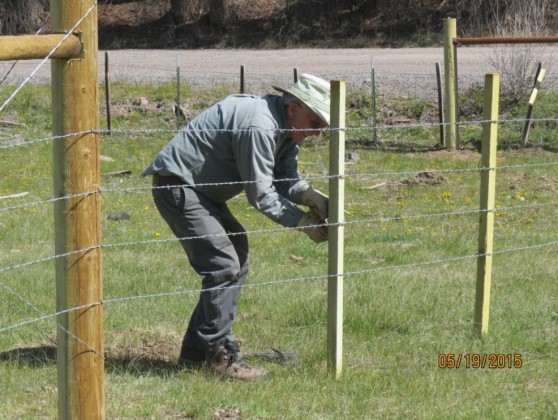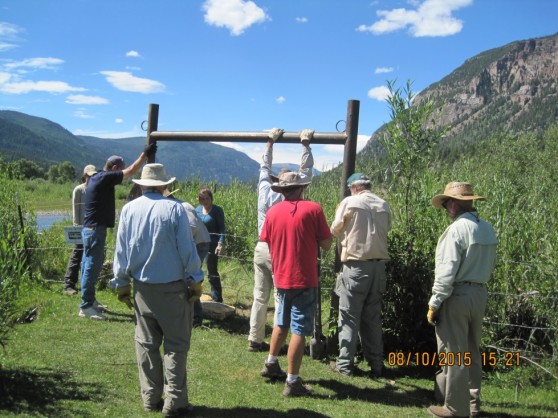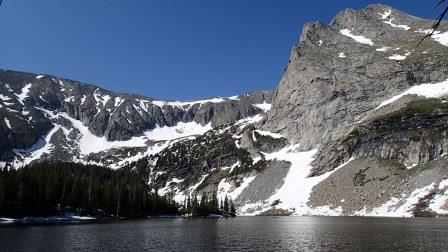That 20" Rainbow you've been going for all day has just been netted. You hand the camera to a buddy, grab the trout out of the net and hold it up at eye level so the world can see the ear-to-ear grin. Upon reviewing the photo, you ask for another one- still holding the fish two feet above the water. The photo is finally good enough for Facebook so you place the fish into the river and let it hang in the water for a second before it regains strength and swims away awkwardly while high-fives are shared.
The "Catch and Release" hashtag may tell everyone that the fish is back out there to be caught again, but the grip-n-grin picture shows an entirely different scenario.
That beautiful rainbow may have swam away. It's energy may seem like it was back to normal, but the fish is actually still in distress- and when trout are in distress, the chances of it dying are significantly increased.
The Fight
It all starts when the hook is set and the fight begins. According to Dr. Andy Danylchuk, an associate professor of fish conservation at the University of Massachusetts Amherst, fish release sugar (glucose) into their blood to fuel muscle activity and fight when they are hooked. When the excess glucose levels are released, it causes a build up of lactate in the blood and can have long-lasting affects on muscle function. This is the same issue that occurs in humans when they suffer a cramp during exercise.
It's best practice to not play with the fish to the point of exhaustion. Do everything you can to land the fish as quickly as possible.
Air Exposure and Handling
Once the fish is landed, the stress doesn't end. In fact it could be increased due to prolonged air exposure and poor handling techniques.
Taking the fish out water essentially stops the trout's ability to breathe. Fish breathe air by taking water in through their mouth, over the gills and out through the gill flaps (the operculum). "Taking fish out of the water stops dissolved oxygen from getting into the blood via the gills. No, the gills are not adapted to capture oxygen from air," says Dr. Danylchuck. "We are forcing the fish to hold its breath after running a race."
Even if the fish is out of water for only a few seconds, harm could still be done through improper handling. When handling a fish, always wet your hands prior to any touching. Trout have a protective coating (a slime layer) that protects them from disease. Wet hands reduce the risk of rubbing too much of the slime layer off. Adversely, when touched with dry hands, the coating is likely to rub off the trout's skin onto yours- leaving them exposed to disease.
Reducing exposure and handling time can be aided by using barbless hooks, or simply crimping the barbs on current hooks. If the hook is too deep, "several studies have shown that it is much better to cut the line and leave the hook in place rather than trying to dig the hook out," says Dr. Danylchuck.
Overall, the best practice would be to remove the hook while the fish is in the water.
This isn't to say that taking a fish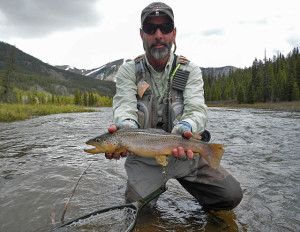 out of water will definitively kill the fish. There are tricks to minimizing air exposure and handling while still getting photo proof of your catch.
out of water will definitively kill the fish. There are tricks to minimizing air exposure and handling while still getting photo proof of your catch.
Allow the cameraman "to call the shots and get the angler to keep the fish in the water until the camera is ready," says Dr. Dalynchuck. Holding the fish only a few inches over the water will also help reduce air time. Regardless of the photo, however, the fish should be dripping wet (which makes the shot look even cooler). Underwater cameras make for a nice image as well.
Releasing
When it comes to releasing trout, it's not as simple as getting it back in the water and then it will be fine, (hopefully, 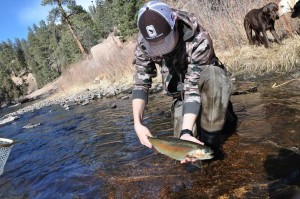 it doesn't need to leave the water). Even when the handling time is minimal, fish still need be released properly as well. When fish have experienced considerable physiological stress due to exercise and handling, they can lose their equilibrium, coordinated movements of their fins and roll or nosedive- resulting in death further on downstream.
it doesn't need to leave the water). Even when the handling time is minimal, fish still need be released properly as well. When fish have experienced considerable physiological stress due to exercise and handling, they can lose their equilibrium, coordinated movements of their fins and roll or nosedive- resulting in death further on downstream.
Good fundamentals in releasing, involve placing the fish in the water with it's head pointing into the current. Remember that the water needs to go through their mouth to exit the gill flap. Anglers should grip the fish lightly and look for coordinated fin movements to show that the fish has their equilibrium and can swim regularly own their own before letting the it go.
"Move a fish in a forward direction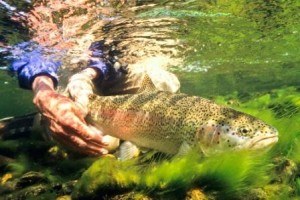 when helping it recover, do not move a fish back and forth—recall that water moving backwards over the gills does not help, but in fact, can actually harm the fish," says Dr. Danylchuck. "Let the fish go when its fins are showing coordinated movements, it can keep itself upright and it is actively trying to swim away from you."
when helping it recover, do not move a fish back and forth—recall that water moving backwards over the gills does not help, but in fact, can actually harm the fish," says Dr. Danylchuck. "Let the fish go when its fins are showing coordinated movements, it can keep itself upright and it is actively trying to swim away from you."
Remember that fish belong in the water and as responsible anglers it's up to us to help protect and keep them there. This includes, keeping the fight time minimal, reducing the trout's air exposure, keeping hands wet, and releasing the fish back into the water properly.
For more information on the affects of keeping fish wet, visit KeepEmWet.org or read Dr. Dalynchuck's Fundamentals of Fish report.







 great way to save money. And like most things, the correct answer is, "It depends." The initial cost of purchasing the tools and materials can range anywhere from $50-200+ but, again, this depends on the quality and quantity of materials.
great way to save money. And like most things, the correct answer is, "It depends." The initial cost of purchasing the tools and materials can range anywhere from $50-200+ but, again, this depends on the quality and quantity of materials. This is great news for those along the Colorado River basin that are depending on a wet winter to bring life back to their crops, reduce drought conditions, and replenish
their reservoirs.
This is great news for those along the Colorado River basin that are depending on a wet winter to bring life back to their crops, reduce drought conditions, and replenish
their reservoirs.




 out of water will definitively kill the fish. There are tricks to minimizing air exposure and handling while still getting photo proof of your catch.
out of water will definitively kill the fish. There are tricks to minimizing air exposure and handling while still getting photo proof of your catch. it doesn't need to leave the water). Even when the handling time is minimal, fish still need be released properly as well. When fish have experienced considerable physiological stress due to exercise and handling, they can lose their equilibrium, coordinated movements of their fins and roll or nosedive- resulting in death further on downstream.
it doesn't need to leave the water). Even when the handling time is minimal, fish still need be released properly as well. When fish have experienced considerable physiological stress due to exercise and handling, they can lose their equilibrium, coordinated movements of their fins and roll or nosedive- resulting in death further on downstream. when helping it recover, do not move a fish back and forth—recall that water moving backwards over the gills does not help, but in fact, can actually harm the fish," says Dr. Danylchuck. "Let the fish go when its fins are showing coordinated movements, it can keep itself upright and it is actively trying to swim away from you."
when helping it recover, do not move a fish back and forth—recall that water moving backwards over the gills does not help, but in fact, can actually harm the fish," says Dr. Danylchuck. "Let the fish go when its fins are showing coordinated movements, it can keep itself upright and it is actively trying to swim away from you."

